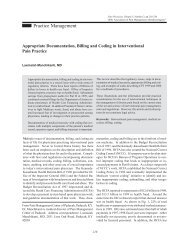ASIPP Practice Guidelines - Pain Physician
ASIPP Practice Guidelines - Pain Physician
ASIPP Practice Guidelines - Pain Physician
You also want an ePaper? Increase the reach of your titles
YUMPU automatically turns print PDFs into web optimized ePapers that Google loves.
Manchikanti et al • <strong>ASIPP</strong> <strong>Practice</strong> <strong>Guidelines</strong><br />
57<br />
Table 12. Results of published reports on lumbar and cervical transforaminal epidural steroid injections<br />
Study<br />
Study<br />
Characteristics<br />
No. of<br />
Patients<br />
Drugs<br />
Utilized<br />
No. of<br />
Injections<br />
Initial Relief<br />
Control vs.<br />
Treatment<br />
Long-term Relief<br />
Control vs.<br />
Treatment<br />
3-4 Weeks (%) 3 Months (%) 6 Months (%)<br />
Riew et al (622) P, RA, DB 55 LA, S 1-4 33 vs. 71 33 vs. 71 33 vs. 71 P<br />
Kraemer et al (624) P, RA, PC, DB 49 S, NS N/A E E E P<br />
Kraemer et al (624) P, RA 87 LA, S N/A E E E P<br />
Shah et al (623) P, PC 48 LA, S 1-4 84 84 84 P<br />
Lutz et al (625) P, C 69 LA, S 1-4 79 79 79 P<br />
Manchikanti et al<br />
(553)<br />
Bush and Hillier<br />
(571)<br />
R, RA 225 S, LA 1-10 91 75 70 P<br />
P, C 68 LA, S 2-3 93 93 93 P<br />
Kikuchi et al (415) R 332 S, LA N/A N/A N/A 64 P<br />
P = prospective; R = retrospective; C = controlled; PC = placebo controlled; RA = randomized; DB = double-blind;<br />
LA = local anesthetic; S = steroids; N/A = not available; NS = normal saline; E = effective; P = positive; VS = versus<br />
Results<br />
in the study, and any patient with more than two levels of<br />
disease. Progress was monitored using the NASS Outcome<br />
questionnaire and a specifically designed nerve root<br />
injection questionnaire. All subjects were assessed at<br />
baseline; at 2, 4, and 8 weeks post-injection; and again at 1<br />
year. The primary outcome measure was whether patients<br />
underwent surgery; but pain, disability, patient satisfaction,<br />
and treatment expectations were also evaluated. Both<br />
groups of patients had similar demographic and clinical<br />
characteristics. They were randomly allocated to receive<br />
an injection of a corticosteroid plus a local anesthetic, or<br />
the anesthetic alone, in a double-blinded manner. All patients<br />
received injections under fluoroscopy, up to four over<br />
the course of the study. All patients had the option of choosing<br />
surgery or participating in the study. Each patient received<br />
one or more additional injections as randomized.<br />
Authors concluded that 71% of the patients studied with<br />
nerve root injections of corticosteroids avoided surgery,<br />
compared to 33% of control subjects. However, patients<br />
who opted not to have surgery showed greater improvement<br />
in terms of pain reduction, functional status improvement,<br />
and expectation of recovery than those who went on<br />
to have surgical intervention. The authors concluded that<br />
selective nerve root injection(s) of corticosteroids were efficacious<br />
in preventing typical spine surgery. They also<br />
speculated that selective nerve root injections might be effective<br />
because they provided more focal delivery of corticosteroids<br />
to the compressive nerves than other types of<br />
epidural injections. This study also showed that the first<br />
injection had the greatest impact on symptoms, with subsequent<br />
injections having less of an effect. The injections<br />
appear to provide benefit for patients with both acute and<br />
chronic complaints. However, it is also important to note<br />
that 33% of the patients in the local anesthetic injection<br />
group also avoided surgery.<br />
Kramer et al (624), in a prospective, randomized, controlled<br />
trial, evaluated the role of lumbar epidural perineural injections.<br />
They included two controlled studies to evaluate<br />
single-shot, selective nerve root injection with a doubleneedle<br />
approach to the anterior epidural space of the lumbar<br />
spinal canal. The trial comprised two controlled studies<br />
on 182 patients. One study compared prospectively<br />
randomized results of patients with lumbar radicular syndromes:<br />
47 received epidural perineural injections, 40<br />
received conventional posterior epidural injections and, 46,<br />
as a control group, received paravertebral local anesthetic<br />
injection. Along with this, a second, prospective, doubleblind<br />
study compared the effect of epidural perineural injections<br />
with triamcinolone in 24 patients and normal saline<br />
in 25 patients. Epidural perineural injections were<br />
more effective than conventional posterior epidural injections.<br />
Both epidural groups had better results than the<br />
paravertebral local injection group. Epidural perineural<br />
injections with steroids utilizing 10 mg of triamcinolone<br />
were more effective than saline alone. A systemic steroid<br />
effect was excluded by additional intramuscular steroid<br />
injections in the normal saline group. The authors con-<br />
<strong>Pain</strong> <strong>Physician</strong> Vol. 4, No. 1, 2001
















